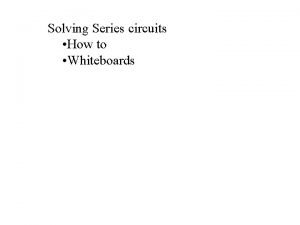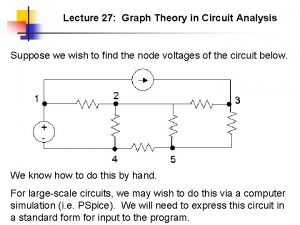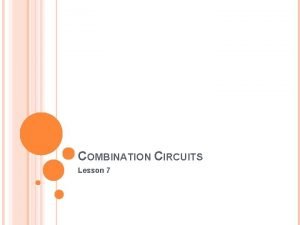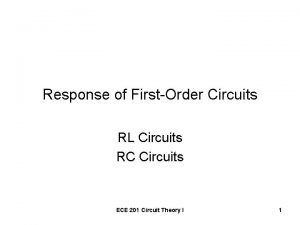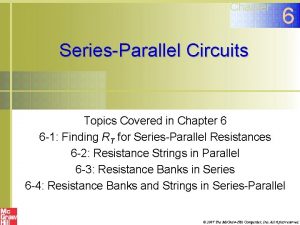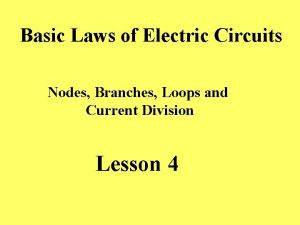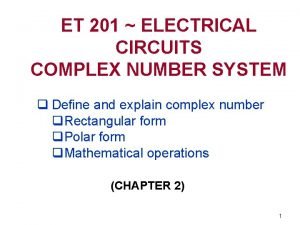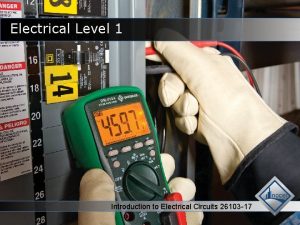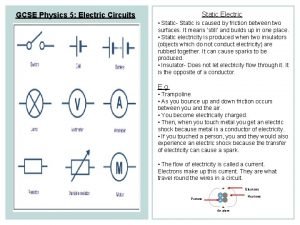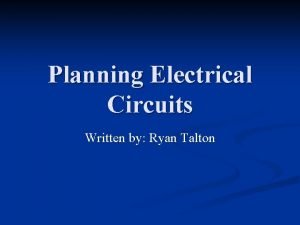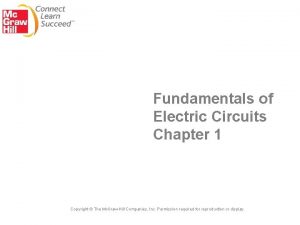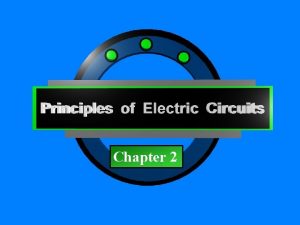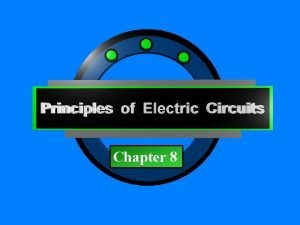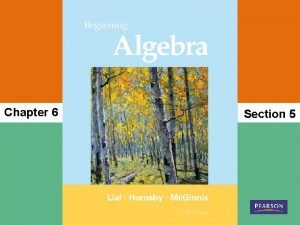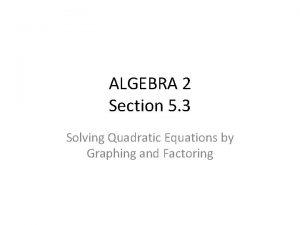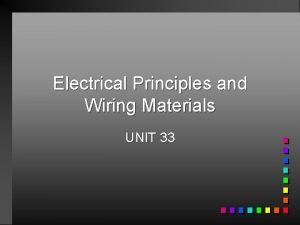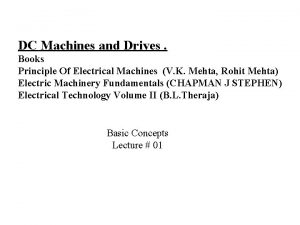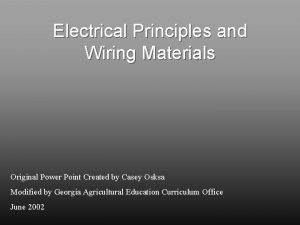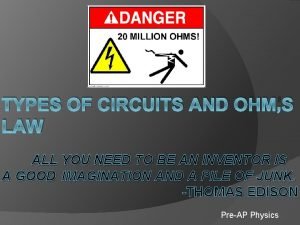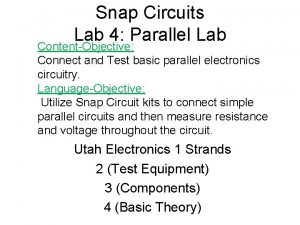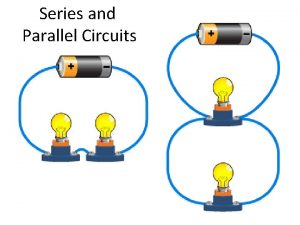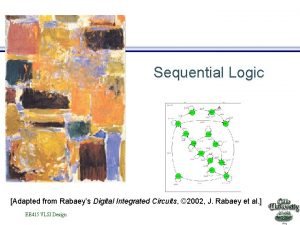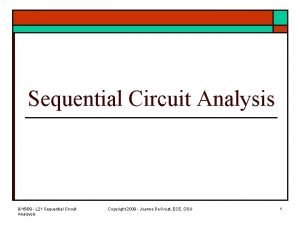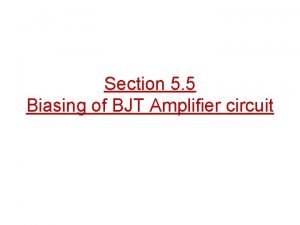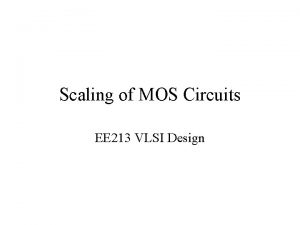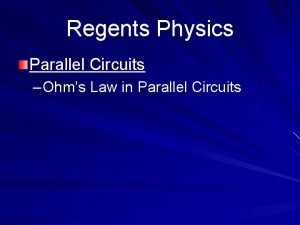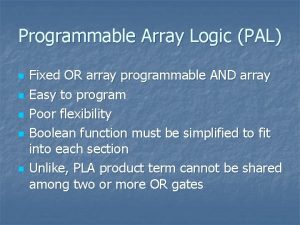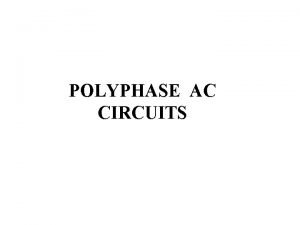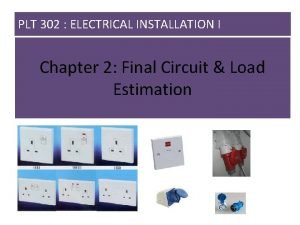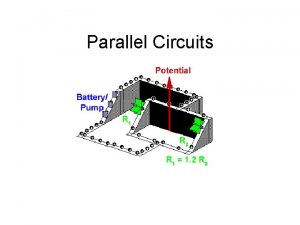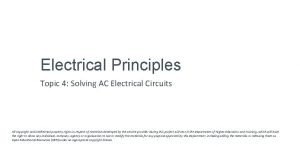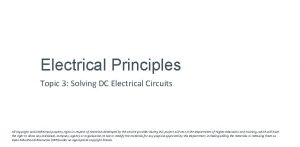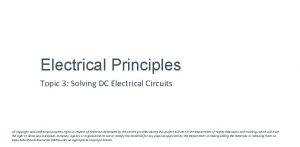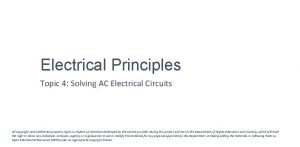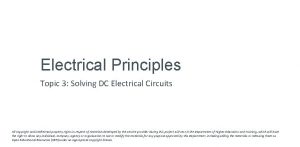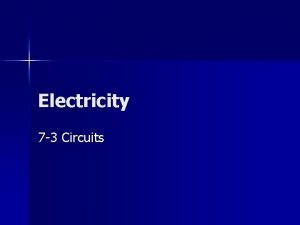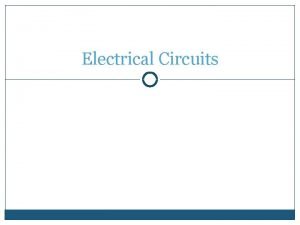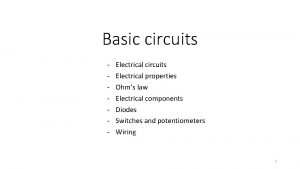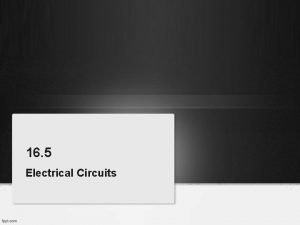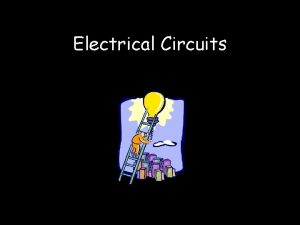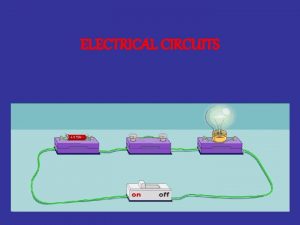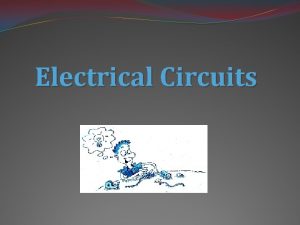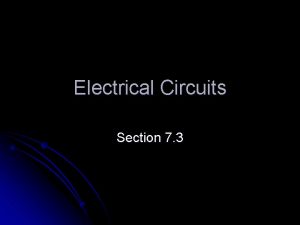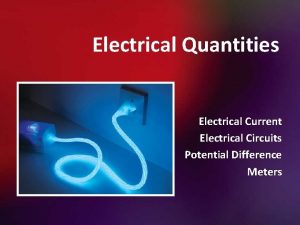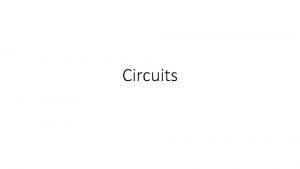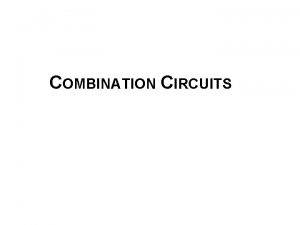Electrical Principles Topic 4 Solving AC Electrical Circuits











































- Slides: 43

Electrical Principles Topic 4: Solving AC Electrical Circuits All copyright and intellectual property rights in respect of materials developed by the service provider during this project will vest in the Department of Higher Education and Training, which will have the right to allow any individual, company, agency or organisation to use or modify the materials for any purpose approved by this Department, including selling the materials or releasing them as Open Educational Resources (OER) under an appropriate copyright license.

Assumed prior learning 05_01_00 05_01_02 05_02_01 05_03_01 05_04_01

Outcomes By the end of this unit the learner will be able to: 1. Explain what the resonant frequency of a series RLC circuit is 2. Describe the conditions present in a resonant or tuned series RLC circuit 3. Calculate the resonant frequency for a series RLC circuit 4. Calculate the capacitance or inductance necessary to achieve resonance in a series RLC circuit.

Unit 4. 7: Resonance in Series RLC Circuits

Introduction We learnt in the previous unit that if XL < XC, the RLC circuit will behave inductively and if XC > XL it will behave capacitively. But what happens when XL = XC? This is the question we will explore in this unit. XL = X C

Summary of RL and RC circuits Before going further, let’s revise some of what we know about series RLC circuits. XL > XC XC > XL

What is resonance? Let’s do an investigation to work out what happens in a circuit when XL = XC. Download and work through the worksheet. Then watch the video to make sure you completed everything correctly. Download the worksheet Vid 01

The resonant frequency Every series RLC circuit will have a specific frequency at which XL = XC. This is called the resonant frequency of the circuit and is give the symbol fr. Watch the video to learn more. Vid 02

Resonant frequency summary The following things happen at the resonant frequency: Click on each point. The inductive reactance (XL) and the capacitive reactance (XC) 1 cancel each other out. 2 All the opposition to current flow is resistive i. e. Z = R. 3 Because impedance is a minimum, current is at a maximum. 4 VL = VX are equal but opposite so cancel each other out. 5 The full supply voltage is dropped over the resistor i. e. VT = VR.

Resonance for series RLC circuits? We need a formula in order to calculate the resonant frequency in any series RLC circuit. Watch the video to find out what this formula is and how we derive it. YT 01

Series RLC resonant circuits – example 1 Let’s put all our new knowledge to work with an example. The circuit is represented is tuned. Calculate the value of the capacitor. 100 V Redraw the circuit on a blank piece of paper. Note: A tuned circuit is one at resonance.

Series RLC resonant circuits – method 1 The first method uses the fact that in a tuned circuit XL = XC. Calculate the inductive reactance, XL. Enter your answer to three decimal places. 100 V XL Ω Check

Series RLC resonant circuits – method 1 • Rearrange the equation and solve for C, the capacitance of the capacitor. Enter your answer to three decimal places C 100 V p. F Check

Series RLC resonant circuits – method 2 • Rearrange the equation and solve for C, the capacitance of the capacitor. Enter your answer to three decimal places. C 100 V p. F Check

Solving series RLC circuits - solution Watch the video to see the full worked solution for this question. You can also have a look at a simulation of the circuit. Full worked solution 100 V

Tuned circuits can store energy There is one property of tuned circuits we have not yet touched on. That is their ability to store energy. Click on the image to open it full screen to learn how this energy is stored. Img 03

The basic tuning circuit One of the many practical uses of resonance is in radio tuning circuits. Here an inductor and variable capacitor are connected in series. When we tune a radio, the LC circuit is set at resonance for a particular radio frequency. Basic tuning circuits use a variable capacitor to tune into different frequencies. Vid 04 Watch the video to see how this works in more detail.

Series RLC resonant circuits – example 2 Here is another resonance circuit example to try. A 10μF capacitor is connected in series with a 20 m. H inductor that also has a resistance of 500Ω. The circuit is supplied with 50 V at 10 k. Hz. Start by drawing and labelling the circuit on a piece of paper. Calculate the: 1. Inductive reactance; 2. Capacitive reactance; 3. Impedance 4. Supply current 5. Voltage across the inductor coil. Represent the resistance of the inductor as a resistor.

Series RLC resonant circuits – step 1 This is what your circuit diagram should have looked like. Correct your diagram if you need to. C= IC IL VC VL IT VT = 50 V

Series RLC resonant circuits – step 2 Now we can start answering the questions. Calculate the inductive reactance, XL. Enter your answer to three decimal places. C= IC IL VC VL IT VT = 50 V XL Ω Check

Series RLC resonant circuits – step 2 Calculate the capacitive reactance, XC. Enter your answer to three decimal places. C= IC IL VC VL IT VT = 50 V XC Ω Check

Series RLC resonant circuits – step 2 Calculate the impedance, Z. Enter your answer to three decimal places. C= IC IL VC VL IT VT = 50 V XC Ω Check

Series RLC resonant circuits – step 2 Calculate the supply current, IT. Enter your answer to three decimal places. C= IC IL VC VL IT VT = 50 V IT m. A Check

Series RLC resonant circuits – step 2 Calculate the voltage across the coil, Vcoil. Enter your answer to three decimal places. C= IC IL VC VL IT VT = 50 V Vcoil V Check

Document Briefing – Doc 01 (1 of 3) Create an annotated PDF worksheet with the following steps. • Make sure you have downloaded the Every. Circuit App from your app store. • If you are working on a computer, visit http: //everycircuit. com/app/. • Open the Every. Circuit app and signup. After your trial, you will still have access to Every. Circuit and other people’s circuits. You will just not be able to create your own circuits. • Go to the community space and search for the circuit called “NOC_Resonance” • Open the circuit. • This circuit has an AC power supply with a frequency of 650 Hz (or 650 cycles per second) and a peak voltage of 9 V. It also has a 30Ω resistor and a 20 m. H inductor and 2μF capacitor. • Start by making a copy of the following table on a piece of paper.

Document Briefing – Doc 01 (2 of 3) f I XL XC Z 650 Hz 700 Hz 750 Hz 800 Hz 850 Hz 900 Hz 950 Hz

Document Briefing – Doc 01 (3 of 3) 1. With the supply frequency at 650 Hz, click on the ammeter and write down the value of the circuit current. Also calculate XL, XC and Z. 2. Now click on the supply and then on the spanner icon. Select Frequency and change it to 700 Hz. Write down the values of the circuit current, XL, XC and Z. Note: you may need to give the simulation time to settle on a current value. 3. Complete the table. 4. At what frequency is a maximum current reached? What is the total impedance in the circuit when the current is a maximum? What is the relationship between the total impedance and the value of R when the current is a maximum? 5. What can you say about the values of XL and XC when the current is a maximum? 6. What are the values for VL and VC when the current is a maximum? Click on the respective voltmeters to find out. 7. On the same set of axes, draw graphs of XL vs f and XC vs f.

Video Briefing – Vid 01 (1 of 2) Create a screencast video presented by an expert presenter. The presenter needs to work through the Doc 01 worksheet and cover and explain the following steps. • Opening the app and opening the circuit for mobile and desktop • Complete the table showing how to do at least 1 column’s changes and calculations (see next slide) • Show that max current happens at 800 Hz. At this frequency XL = XC but because they are in opposite directions (show a phasor diagram) they cancel each other out. • Explain that the total reactance is thus zero and Z = R. Because impedance is at a minimum, current is at a maximum. • All of this only happens when the frequency is 800 Hz. • Show the graphs of XL and XC vs f (see https: //www. desmos. com/calculator/cycwnsry 8 k) and pinpoint where they cross – this frequency is called the resonant frequency (fr )– that frequency where the inductive and capacitive reactances are equal and opposite.

Video Briefing – Vid 01 (2 of 2) f 650 Hz 700 Hz 750 Hz 800 Hz 850 Hz 900 Hz 950 Hz I 175 m. A 225 m. A 276 m. A 299 m. A 276 m. A 234 m. A 195 m. A XL 81. 681Ω 87. 965Ω 94. 248Ω 100. 531Ω 106. 814Ω 113. 097Ω 119. 381Ω XC 124. 291Ω 115. 413Ω 107. 719Ω 100. 987Ω 95. 046Ω 89. 766Ω 85. 041Ω Z 52. 111Ω 40. 662Ω 32. 886Ω 30. 000Ω 32. 226Ω 38. 004Ω 45. 599Ω

Video Briefing – Vid 02 (1 of 4) Create a screencast video presented by an expert presenter explaining resonant frequency with the use of the graphics on the next slides: • We know that inductive reactance is proportional to frequency and so the graph of X L vs f looks like this (Img 02). • We can also plot capacitive reactance vs frequency. Because XC is inversely proportional to f, the graph looks like this (Img 03). • If we combine these graphs we get one that looks like this – it plots reactance vs frequency for both XL and XC (Img 04). • There is a point at which these graphs cross – there is a frequency that makes XL = XC. • This specific frequency is called the resonant frequency fr • At frequencies less than fr, we can see that XC > XL and the circuit will behave capacitively. • At frequencies greater than fr, we can see that XL > XC and the circuit will behave inductively.

Video Briefing – Vid 02 (2 of 4) • At fr we know that XL = XC, but because they are equal and opposite they cancel each other out. • Open https: //www. desmos. com/calculator/2 qtekovc 0 a • Here is a simple resonant frequency simulation • The purple graph is capacitive reactance • The green graph is inductive reactance • We can change the values of L and C and we can see that this changes the shape of each graph. • But there is always a point where they cross. This is fr. • On the side we have the phasor diagram. As we increase f from zero, we can see that X C is larger than XL and that the circuit is capacitive. The overall voltage lags the current. • But as we get closer and closer to fr so XC and XL approach the same value until at fr they are equal (but opposite) and cancel each other out. The voltage is in phase with the current and the circuit behaves resistively. In other words there is no reactance and

Video Briefing – Vid 02 (3 of 4) • Also at fr, and VL = VC. Remember the voltage drop across these components is in proportion to their reactances so if XL = XC , then VL = VC. But because they are opposite, like reactance, they cancel each other out and all the supply voltage is dropped over the resistor i. e. VT = VR. • Past fr, XL is bigger than XC and the circuit will be inductive. Overall, voltage will lead current. • Notice that we can keep frequency the same and change the values of L or C to find resonance.

Video Briefing – Vid 02 (4 of 4)

Video Briefing – Vid 03 (1 of 3) Create a screencast video presented by an expert presenter. The presenter needs to work through the question in example 1. The circuit is represented is tuned. Calculate the value of the capacitor. Note: A tuned circuit is one at resonance. 100 V

Video Briefing – Vid 03 (2 of 3)

Video Briefing – Vid 03 (3 of 3)

Video Briefing – Vid 04 (1 of 1) Create a screencast video presented by an expert presenter explaining the working of a basic tuning circuit using https: //www. desmos. com/calculator/y 6 pljojunw. Set f = 360, L = 200, C = 1 and R = 200. • Explain the working of a basic tuning circuit. • If we want to tune into the frequency of 360, we need to increase the capacitance of the capacitor. As we do so, we change the shape of the capacitive reactance graph. • As we increase C, we eventually tune the circuit by making the XC = XL for the desired frequency. In this simulation, we had to make C = 260. • The same circuit could, in principle, be designed with a variable inductor but in practice simple tuning circuits use variable capacitors. • In these circuits, the inductor provides both the inductance and the resistance. Remember that an inductor is really just a piece of wire. It is this wire that offers resistance to the flow of current.

Image Briefing – Img 03 (1 of 5) Create a set of images with descriptive text as described, including the simple back/forward navigation. Part A: In a LC circuit, the capacitor stores energy in the electric field between its plates. The amount of energy depends on the voltage across it. The indictor stores energy in its magnetic field, depending on the current through it. At some point, the capacitor will be full charged. Next

Image Briefing – Img 03 (1 of 5) Part B: If an indictor is connected to the capacitor, current will start to flow through the inductor, building up a magnetic field. Back Next

Image Briefing – Img 03 (1 of 5) Part C: Current will flow until all the charge in the capacitor is gone and its voltage is zero. Back Next

Image Briefing – Img 03 (1 of 5) Part D: However, the current will continue flowing because an indictor resists changes in current. The current will begin to charge the capacitor with the opposite polarity to before. Back Next

Image Briefing – Img 03 (1 of 5) Part E: Current will continue to flow until the inductor magnetic field has completely collapsed and all the charge is again stored in the capacitor but with the opposite polarity. The cycle begins again. Back Next

Image Briefing – Img 03 (1 of 5) Part F: Therefore, charge flows back and forth between the plates of the capacitor through the inductor. Energy would oscillate back and forth between the capacitor and the inductor for ever were it not for the internal resistance in the wires of the circuit. However, if we connect the circuit to an external AC power supply at the same resonant frequency, we keep the oscillations going. Back
 Advantages of parallel circuit over series circuit
Advantages of parallel circuit over series circuit Solving series circuits
Solving series circuits Abdcefgh
Abdcefgh Solving combination circuits
Solving combination circuits Solving first order circuits
Solving first order circuits Solving parallel circuits
Solving parallel circuits Parallel circuit vs series circuit
Parallel circuit vs series circuit Nodes branches and loops formula
Nodes branches and loops formula Complex numbers in electrical circuits
Complex numbers in electrical circuits Nccer introduction to electrical circuits
Nccer introduction to electrical circuits Electrical circuits gcse
Electrical circuits gcse Planning electrical circuits
Planning electrical circuits A circuit is
A circuit is Clincher sentence examples
Clincher sentence examples Narrow down the topic
Narrow down the topic Principles of electronic circuits
Principles of electronic circuits Principles of electric circuits 10th edition answer key
Principles of electric circuits 10th edition answer key Section 5 topic 3 solving quadratic equations by factoring
Section 5 topic 3 solving quadratic equations by factoring Chapter 9 solving quadratic equations
Chapter 9 solving quadratic equations Section 5 topic 3 solving quadratic equations by factoring
Section 5 topic 3 solving quadratic equations by factoring Electrical wiring materials
Electrical wiring materials Principles of electrical machines vk mehta
Principles of electrical machines vk mehta Principles and applications of electrical engineering
Principles and applications of electrical engineering Allan
Allan Unit 33 electrical principles and wiring materials
Unit 33 electrical principles and wiring materials Lesson outline lesson 3 describing circuits answers
Lesson outline lesson 3 describing circuits answers Virtual circuit switching example
Virtual circuit switching example Types of circuits
Types of circuits Spinal cord
Spinal cord Isolated instrumentation amplifier
Isolated instrumentation amplifier Snap circuits lab
Snap circuits lab Voltage in parallel circuit
Voltage in parallel circuit Facts about series and parallel circuits
Facts about series and parallel circuits Non bistable sequential circuits
Non bistable sequential circuits Analysis of sequential circuits
Analysis of sequential circuits What is biasing
What is biasing Scaling factor in vlsi
Scaling factor in vlsi Physics regents circuit questions
Physics regents circuit questions Programmable array logic circuit
Programmable array logic circuit What is a incomplete circuit
What is a incomplete circuit Polyphase ac
Polyphase ac Radial circuits
Radial circuits Contoh rangkaian sekuensial
Contoh rangkaian sekuensial Types of circuits
Types of circuits

